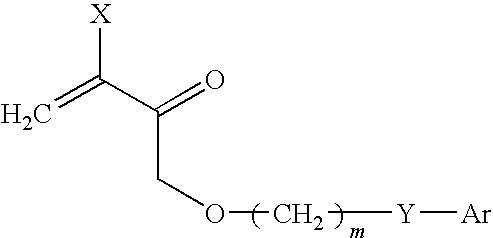Biocompatible polymers and co-polymers, and uses thereof
a biocompatible polymer and co-polymer technology, applied in food science, medical science, pharmaceutical non-active ingredients, etc., can solve the problem of not significantly improving the biocompatibility of polymers, and achieve the effect of high refractive index and high refractive index
- Summary
- Abstract
- Description
- Claims
- Application Information
AI Technical Summary
Benefits of technology
Problems solved by technology
Method used
Image
Examples
example 1
Synthesis of Acryl Lysine Monomers Via Copper Complex
[0041]14.62 g (0.1 moles) L-lysine (Fluka 62840) was dissolved in 150 ml deionized water and heated to about 80° C. 16.6 g (0.075 moles) copper carbonate (Fluka 61167) were added in portions during about 30 minutes. The reaction mixture was subsequently heated in a closed system and stirred during about 30 minutes. The hot, deep-blue suspension was filtered through silicagel. The filter was washed with a small amount of water. On the subsequent day, the lysine-copper complex-containing filtrate was cooled in an icebath, and 100 ml tetrahydrofuran were added. Acryl chloride (8.9 ml; 0.11 moles; Fluka 01780) was added dropwise during a period of about an hour. The pH was initially maintained between 8 and 10 by parallel, dropwise addition of 10% sodium hydroxide. After about half of the acryl chloride solution had been added, product began to precipitate. As most of the acryl chloride had been added, base addition was slowed to allo...
example 2
Synthesis of Acryl Serine, Acryl Threonine, Acryl Tyrosine, Acryl Oxiproline and Acryl Cysteine
[0043]Synthesis of these compounds was performed as described in Example 1. For acryl cysteine, the starting material was cystine.
example 3
Synthesis of Fmoc-Acryl-Lysine
[0044]10 g of acryl-lysine were dissolved in 106 ml of a 10% (wt / vol) solution of sodium carbonate in water and diluted with 100 ml dioxane. 14 g Fmoc-chloride dissolved in 50 ml dioxane were added to the reaction mixture over a period of 30 minutes at 15-25° C. The reaction mixture was stirred for 3 h at room temperature and then adjusted to pH2 with the addition of 10% aqueous HCl. After extraction with ethyl acetate, the organic phase was evaporated to dryness. 21.4 g of the resulting clear yellowish oil were put on 200 g silicagel and washed with ethyl acetate. The product was extracted from the silicagel with 3:1 (vol / vol) ethyl acetate / methanol. After evaporation of the solvent, a white powder (10.4 g equal to a 50% yield) was obtained. The structure of the compound was verified by NMR.
PUM
| Property | Measurement | Unit |
|---|---|---|
| Glass transition temperature | aaaaa | aaaaa |
| Electrical conductor | aaaaa | aaaaa |
| Hydrophilicity | aaaaa | aaaaa |
Abstract
Description
Claims
Application Information
 Login to View More
Login to View More - R&D
- Intellectual Property
- Life Sciences
- Materials
- Tech Scout
- Unparalleled Data Quality
- Higher Quality Content
- 60% Fewer Hallucinations
Browse by: Latest US Patents, China's latest patents, Technical Efficacy Thesaurus, Application Domain, Technology Topic, Popular Technical Reports.
© 2025 PatSnap. All rights reserved.Legal|Privacy policy|Modern Slavery Act Transparency Statement|Sitemap|About US| Contact US: help@patsnap.com



